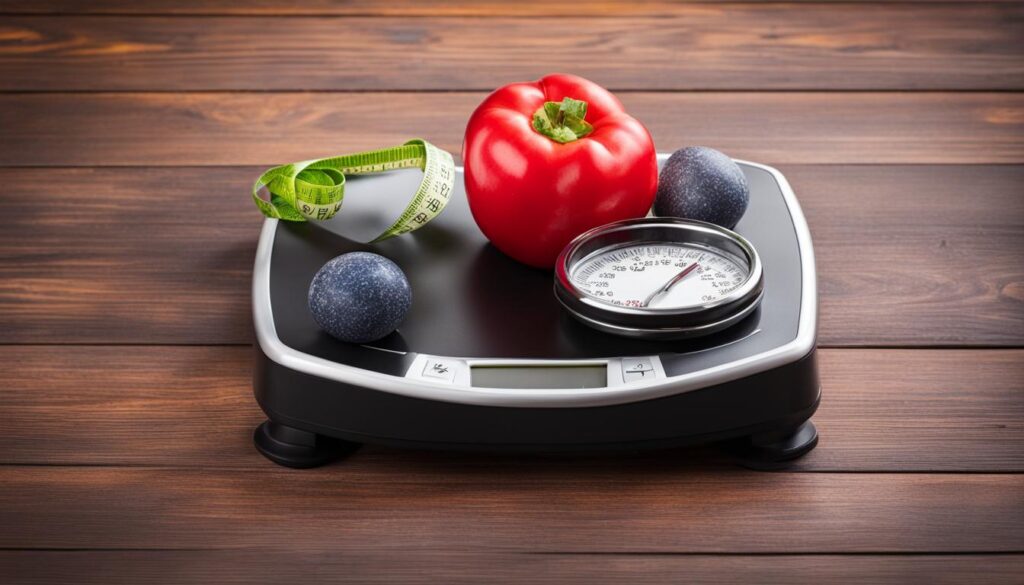Are you struggling to lose weight? Do you find yourself constantly searching for the best diet plan to fit your needs? Look no further. In this article, we will guide you on how to calculate macros for weight loss. By following these simple steps, you can create a personalized diet plan to accomplish your weight loss goals.
With our easy-to-understand explanation of macro calculation, you can take control of your diet and achieve success. This article will also explain why macros matter in the context of weight loss, which macronutrients you should focus on, and how to establish your macro ratio based on your body weight, goals and lifestyle.
Don’t let diet confusion hold you back any longer. Learn how to calculate how many macros for weight loss, and create a diet plan that suits your unique body and lifestyle.
Table of Contents
Why Macros Matter for Weight Loss
Understanding the role of macros in weight loss is crucial for creating an effective plan. Macros are the macronutrients – protein, carbohydrates, and fats – that make up the calories in our food. Each macronutrient plays a vital role in our body’s functioning, and a proper balance is vital for optimizing fat loss and maintaining body weight.
For example, protein helps repair and build tissues, which is especially important for those engaging in high-intensity exercise or strength training. Carbohydrates provide energy and are essential for many body functions, while fats support critical hormone production and overall health. Without the right balance and consideration for your specific goals and body weight, weight loss may be difficult to achieve.
The Importance of Macros for Fat Loss and Body Weight
Research shows that properly balancing macronutrients can help optimize fat loss without causing muscle loss or other negative effects on the body. When following a weight loss program that consists of balanced macros and meets calorie needs, you can lose fat while maintaining or even increasing muscle mass.
Tracking macros can help ensure that you’re meeting your macro goals and making progress. It can also help determine if your body weight loss stalls, allowing you to adjust your macros and maintain a calorie deficit. Additionally, keeping macronutrient goals in mind can help prevent overeating and binging on unhealthy foods.
Creating a Balance of Macros for Your Body Weight and Goals
The balance of macros you need to consume depends on various factors, including body weight, height, age, activity level, and goals. A widely used approach for effective fat loss is to consume around 1 gram of protein per pound of body weight. For carbohydrates and fats, the remaining calories can be divided based on individual needs and preferences.
Ultimately, striking a balance of macros will depend on your specific goals. For example, the balance of macros for a person trying to lose weight will be different from someone trying to gain muscle. By considering various factors and carefully tracking your macros, you can create a tailored plan that will help you achieve your desired results.
The Three Macronutrients: Protein, Carbs, and Fat
Macronutrients are the essential nutrients that our body requires in large amounts to function correctly. The three primary macronutrients are protein, carbohydrates, and fat. To achieve effective weight loss, a proper balance between these macronutrients is necessary.
| Macronutrient | Role in the body | Sources |
|---|---|---|
| Protein | Helps build and repair tissues, aids in muscle recovery and growth | Chicken, beef, fish, eggs, nuts, legumes, tofu |
| Carbohydrates | Provides energy for the body to function | Whole grains, fruits, vegetables, legumes |
| Fat | Supports vital functions such as hormone production, vitamin absorption, and insulation | Nuts, seeds, avocado, olive oil, fatty fish |
By properly balancing these macronutrients in your diet, you can optimize weight loss and maintain a healthy weight. Consuming adequate amounts of protein can help preserve muscle mass during weight loss, while carbohydrates and fats provide energy and support various bodily functions.
Determine Your Calorie Needs
Before you can calculate your macros, you need to determine your daily calorie needs. Your basal metabolic rate (BMR) is the number of calories your body burns at rest. To estimate your BMR, you can use a BMR calculator or calorie deficit calculator.
These calculators take into account your age, gender, height, and weight. By knowing your BMR, you can estimate the number of calories you need to consume each day to achieve your weight loss goals.
Establishing Your Macro Ratio
Calculating your macro ratio is a vital aspect of achieving effective weight loss. Your macro ratio determines the percentage of calories obtained from each macronutrient, including protein, carbs, and fats, that suit your body’s needs. To optimize your fat loss and muscle gain, identifying the appropriate macro ratio is crucial while considering your body type, activity level, and goals.
For instance, a higher proportion of protein is required for muscle gain, while a lower ratio of carbs may suffice for weight loss. In general, a balanced macro ratio breakdown is approximately 40% carbs, 30% protein, and 30% fats.
| Macronutrient | Number of Calories per Gram | Recommended Ratio |
|---|---|---|
| Protein | 4 | 30% – 35% |
| Carbohydrates | 4 | 40% – 45% |
| Fats | 9 | 20% – 25% |
However, depending on your goals, body type, and level of activity, you may adjust your macro ratio to suit your unique needs. For instance, someone with a faster metabolism may require more carbohydrates, while someone with a slower metabolism may need higher protein intake for optimal muscle growth.
Keep in mind that consuming too few calories or excessively limiting a particular macronutrient will negatively affect your goals. Therefore, establishing the right macro split is essential in achieving successful fat loss and muscle gain.
Calculator can provide Macros Based on Body Weight
Calculating macros based on body weight is a widely used approach in creating a personalized diet plan. Protein plays an essential role in effective weight loss by maintaining muscle mass. To achieve this, aim for consuming around 1 gram of protein per pound of body weight. This amount can vary depending on your activity level and goals.
The remaining calories can be divided between carbohydrates and fats. The appropriate amount depends on the individual and their goals. For fat loss, aim for a calorie deficit in which less energy is consumed than expended. For muscle gain, a calorie surplus is needed, and the excess calories should come from carbohydrates and fats. Tracking your macros helps ensure that your diet remains on track and that your body is receiving the nutrients it needs.
Tracking macros and calculating them based on body weight can take some time and effort, but the results are worth it. By staying consistent and maintaining your macro split, you can achieve successful weight loss and muscle gain. Remember to also consider other factors such as exercise, sleep, and stress management in your weight loss journey.
Tracking Your Macros
Tracking your macros is essential to ensure that you stay within your desired ranges and achieve your weight loss goals. There are various ways to track your macros, including manually using a food diary or taking advantage of tracking apps that make the process more convenient today.
Using a food diary is a simple yet effective way of tracking your macros. You can use a notebook, spreadsheet, or a printable template to record your daily intake of protein, carbs, and fat. Additionally, various mobile apps like MyFitnessPal, FatSecret, and LoseIt! allow you to track your macros on-the-go. These apps provide a vast database of foods, including specific brands and restaurants, to make tracking more comfortable and convenient.
Another popular way to track your macros is through wearable devices like Fitbit and Apple Watch. These devices track your physical activity and estimate calorie burn, providing insight into the number of macros your body needs that day. Many of these devices sync with your preferred tracking apps, making the process even more straightforward.
Benefits of Tracking Macros
Tracking your macros can not only help you lose weight but also improve your overall health. By tracking your macros, you can have a better understanding of the types and amounts of food you’re consuming, which can help you maintain a balanced diet. Additionally, tracking can be an eye-opening experience, showing where you may have been unknowingly consuming excess amounts of certain macros.
Moreover, tracking can help you make more informed food choices, allowing you to adjust your diet to meet your specific goals. For example, if you’re not hitting your protein goals, you can add more high-protein foods to your diet. On the other hand, if you’re consuming too many carbs or fats, you can adjust your intake accordingly.
Overall, tracking your macros is a simple yet powerful tool for achieving successful weight loss. By understanding the types and amounts of macronutrients your body needs and staying within your desired ranges, you can optimize fat loss and improve your overall health.

Using a Macro Calculator
If calculating your macros manually seems overwhelming, don’t worry! There are many macro calculators available online that can do the work for you.
A macro calculator is an online tool that considers various factors such as your gender, age, weight, activity level, and goals to provide a personalized macro recommendation. Using a macro calculator ensures that your macros are tailored to your specific needs and goals, eliminating the need for complex calculations.
Simply enter your information into the calculator, and it will generate your recommended daily intake of protein, carbohydrates, and fats based on your goals. This makes it easy to create a custom diet plan that is designed to help you achieve your weight loss goals.
Using an online calculator not only simplifies the process of macro calculation but also provides a more accurate estimate of your daily caloric needs. By having a personalized macro ratio, you can ensure that you’re consuming the right amount of nutrients to promote fat loss and maintain muscle mass.
The Role of Protein in Weight Loss
When it comes to weight loss, consuming an adequate amount of protein is crucial. Not only does protein help preserve muscle mass during a calorie deficit, but it also plays a role in promoting satiety. This can aid in reducing overall calorie intake, helping with fat loss.
According to nutrition experts, consuming around 1 gram of protein per pound of body weight is recommended for fat loss and muscle gain. In simple terms, this means if you weigh 150 pounds, you should aim to consume approximately 150 grams of protein per day. However, it’s important to remember that the amount of protein you need may vary based on factors like activity level, age, and gender.
Tracking your macros using a food diary or through the use of various tracking apps can help ensure you’re consuming the recommended amount of protein and staying within your desired calorie range. Aim to include protein-rich foods like lean meats, fish, eggs, dairy, legumes, and tofu in your diet.
Furthermore, consuming adequate protein can also help preserve muscle mass during weight loss. When we lose weight, some of this weight can come from muscle loss. However, consuming enough protein can help prevent this muscle loss, as well as improve muscle protein synthesis.
Finding the Right Carbohydrate and Fat Balance
The key to a successful macro split is finding the right balance between carbohydrates and fats. Both these macronutrients provide your body with the necessary energy to function effectively, but inadequate or excessive intake can lead to negative effects on your health and weight loss goals.
When it comes to carbohydrates, it’s recommended to choose high-quality sources like fruits, vegetables, and whole grains that are rich in fiber, vitamins, and minerals. These foods have a low glycemic index and are slowly digested, keeping you feeling fuller for longer while promoting weight loss.
Fats also play a vital role in your diet, aiding in hormone regulation and promoting feelings of satiety. However, not all fats are created equal, and it’s essential to consume healthy fats like those found in avocados, nuts, and fatty fish while limiting your intake of saturated and trans fats found in processed foods.
| Carbohydrates | Fats |
|---|---|
| Best Choices | Best Choices |
| Whole grains like brown rice and quinoa | Healthy fats like avocado and nuts |
| Fruits like berries and apples | Fatty fish like salmon and tuna |
| Leafy vegetables like spinach and kale | Extra virgin olive oil and coconut oil |
By considering the right balance of carbohydrates and healthy fats in your daily meals and snacks, you can optimize your calorie and macro split and achieve effective weight loss while promoting overall health and wellbeing.
Adjusting Macros for Specific Goals
One of the benefits of macro calculation is the flexibility it offers in adjusting your diet based on specific goals. Whether you want to gain weight, lose belly fat, lose overall weight, or gain muscle, adjusting your macros can help you achieve the desired outcome.
Gaining Weight or Muscle
If your goal is to gain weight or muscle, increasing your calorie intake is necessary. You’ll need to set your macros to have a surplus of calories and increase your protein intake to support muscle growth. Generally, consuming around 1.2-1.6 grams of protein per pound of body weight is recommended for optimal muscle gain. Focus on strength training as you aim to gain weight or muscle.
Losing Belly Fat or Weight in General
If you’re focused on losing belly fat or losing weight in general, adjusting your macros for a calorie deficit is necessary. This means consuming fewer calories than your body burns each day. Reducing your calorie intake and increasing protein can help preserve muscle mass during fat loss. Aim to consume around 0.8-1 gram of protein per pound of body weight and focus on incorporating high-intensity interval training into your exercise routine for maximum fat loss.
Tracking Your Progress
As you adjust your macros, it’s important to track your progress to determine if you’re making progress towards your goals. You can track your weight, body fat percentage, and body measurements to assess your progress. Adjust your macros as necessary to ensure you’re on track to reaching your desired outcome.
Strategies for Successful Weight Loss
Count macros for Weight loss goals can be achieved not only through macro calculations but also by implementing effective loss strategies. Combining macro calculations with the right strategies enhances the success of the weight loss journey. Here are some strategies that can help achieve your desirable outcomes:
- Meal Planning: Preparing a healthy meal plan is essential for effective weight loss. Planning helps to avoid unhealthy foods, manage portion size, and save time. Meal prep can also be a lifesaver and facilitate healthier food choices when hunger strikes.
- Portion Control: Healthier food choices are not enough; you also need to learn how to control your portions. Rather than guessing, use a food scale or measuring cups to monitor your food portions. Reducing your portions can help you consume fewer calories without feeling deprived.
- Mindful Eating: We often eat while doing other activities which leads to overeating and mindless consumption of calories. Practicing mindful eating involves focusing on the food, savoring each bite and enjoying the full experience of eating. Mindful eating enables you to eat slowly and tune into your hunger and fullness signals.
- Regular Exercise: Physical activity is essential for overall health and weight loss. Aim to do 30 minutes of moderate exercise per day, such as brisk walking, cycling, or swimming. Work with a certified trainer to develop an exercise plan that is tailored to your goals.
Combining Strategies for Maximum Results
Using just one of these strategies alone may not be enough to achieve your weight loss goals. It’s advisable to combine two or more strategies at the same time to maximize your effort. For instance, combining meal planning and portion control can help you avoid unhealthy foods and manage your calorie intake. Additionally, incorporating regular exercise and mindful eating can boost metabolism and improve satiety signals, making it easier to adhere to your macros.
Remember that weight loss is a gradual process that requires patience and consistency. Following these strategies along with tailoring a personalized macro calculation will help you achieve your desirable results.
Maintaining Your Weight with Macros
Upon achieving your weight loss goals, it’s essential to maintain your progress. This can be done by adjusting your macros to match your new weight maintenance needs. Hitting your macros and maintaining a balanced diet will help prevent weight regain.
Remember that the number of calories you consume affects your weight. To maintain your weight, you must continue to consume an appropriate number of calories based on your metabolism and activity level.
At this stage, it’s best to experiment with different macro ratios to find what works best for you. Keep an eye on your progress. If you notice your weight increasing, it might be time to adjust your macros.
It’s important to note that maintain your weight doesn’t mean you should continue to restrict your calorie intake. Instead, focus on consuming enough to maintain your weight while nourishing your body with healthy food choices.
Tracking your progress and continuously hitting your macros to lose weight can help you stay on track in maintaining your strategies for weight loss.
Conclusion
Now that you’ve learned how to calculate macros and the importance of macro counting, you’re well on your way to achieving successful weight loss. Remember to focus on finding the best macro ratio for your body and goals, whether it’s for keto macros or any other diet plan.
Tracking your macros and adjusting them as needed is key to maintaining a well-balanced and healthy diet. Keep in mind that there isn’t a single “best macro” that works for everyone. It’s essential to find the right balance of macros that works for you and your lifestyle.
With the knowledge and strategies provided in this article, you can achieve your weight loss goals and maintain a healthy weight in the long term. Incorporate sustainable lifestyle habits into your routine, and you’ll be well on your way to successful weight loss without having to rely on fad diets or extreme measures.
So start calculating your macros today and take the first step towards achieving your weight loss goals with confidence!
FAQ
How do I calculate my macros for weight loss?
To calculate your macros for weight loss, you need to determine your calorie needs first. Then, establish your desired macro ratio by considering factors such as activity level, body type, and goals. Finally, divide your calories between protein, carbohydrates, and fats based on your body weight.
Why are macros important for weight loss?
Macros, or macronutrients, are the building blocks of our diet. By understanding the right balance of protein, carbs, and fats based on your body weight and goals, you can optimize fat loss while maintaining muscle mass. Macros play a crucial role in effective and sustainable weight loss.
How much protein should I consume for weight loss?
It is recommended to consume around 1 gram of protein per pound of body weight for weight loss. Protein helps preserve muscle mass during a calorie deficit and promotes satiety, which can aid in reducing overall calorie intake.
How do I track my macros?
You can track your macros manually using a food diary or by using various tracking apps. These tools allow you to log your meals and calculate the grams of each macro you consume throughout the day to ensure you stay within your desired ranges.
Can I use a macro calculator to calculate my macros diet?
Yes, utilizing a macro calculator provides can simplify the process of calculating your macros. Online calculators consider factors such as gender, age, weight, activity level, and goals to provide you with personalized macro recommendations, eliminating the need for complex calculations.
How do I adjust my macros for specific goals?
Depending on your goals, you may need to adjust your macros accordingly. If you want to gain weight or muscle, you’ll likely need an increase in calories and protein. If your focus is on losing belly fat or losing weight in general, adjusting your macros for a calorie deficit is necessary.
What strategies can I use for successful weight loss?
Alongside calculating macros, implementing effective weight loss strategies is crucial. These may include meal planning, portion control, mindful eating, and regular exercise. Combining a well-designed macro plan with these strategies will maximize your weight loss results.
How do I maintain my weight safely with macros?
Once you’ve reached your weight loss goals, it’s important to adjust your macros to match your new weight maintenance needs. Continuously hitting your macros and maintaining a balanced diet will help prevent weight regain and ensure long-term weight maintenance.
How can I learn more about calculating macros?
To learn more about macro calculator first, you can consult nutrition resources, hire a registered dietitian or nutritionist, or explore reputable online sources. Understanding the principles of macro counting and how to customize your macros can help you achieve successful and sustainable weight loss.



